Are Mushrooms Healthy for You?
Blue indicates link
We have quite a variety of mushrooms out there, their health benefits and some of the prices were quite surprising to me. I remember walking through different forested areas and noticing them, but not paying too much attention to them. I also did not realize that some of them were expensive delicacies served in some expensive restaurants. I have watched some cooking shows, particularly by, Chef Gordon Ramsey, and the attention paid to cooking these.
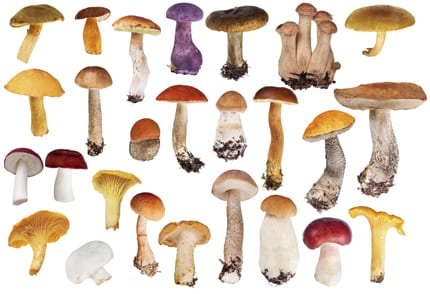
Recently a friend was asking me if I have ever considered adding mushrooms to my website. Now, why would I do that? It was at this time I was introduced to the health benefits of this plant. I decided to do some research, to find out more, and I would like to share with you my discoveries.
About Mushrooms
Mushrooms are an edible fungus that can provide several important nutrients. The many kinds of mushrooms have varying compositions and nutritional profiles.
Mushrooms are packed with nutritional value. They’re low in calories and are great sources of fiber and protein (good for plant-based diets).
Mushrooms and the Health of Our Planet
Mushrooms are good for you. And they’re also good for our planet. As world-renowned mycologist Paul Stamets discusses, mushrooms can potentially solve some of our most pressing and serious problems.
In his wildly popular TED talk, he explains how they can:
- Clean up oil spills all over the world
- Absorb farm pollution
- Fight off smallpox and flu viruses
- Combat insects
- Create rich environments for farms and new forests, and
- Become a sustainable fuel source for the future
They also provide many important nutrients, including B vitamins, selenium, potassium, copper, and (particularly when exposed to the sun) vitamin D. And even though they’re commonly white, they’re packed with as many antioxidants as more colorful fruits and vegetables.
What are the health benefits of mushrooms?
Mushrooms contain protein, vitamins, minerals, and antioxidants. These can have various health benefits. For example, antioxidants are chemicals that help the body eliminate free radicals.
Free radicals are toxic byproducts of metabolism and other bodily processes. They can accumulate in the body, and if too many collect, oxidative stress can result. This can harm the body’s cells and may lead to various health conditions.
Among the antioxidant agents in mushrooms are:
- selenium
- vitamin C
- choline
Cancer
The antioxidant content in mushrooms may help prevent lung, prostate, breast, and other types of cancer, according to the National Cancer Institute. Some sources have suggested that selenium may help prevent cancer, but a Cochrane review, from 2017, found no evidence to confirm this.
Mushrooms also contain a small amount of vitamin D. There is some evidence that vitamin D supplementation may help prevent or treat some kinds of cancer, though according to a 2018 report, the effect may vary from person to person.
Choline is another antioxidant in mushrooms. Some studies have suggested that consuming choline can reduce the risk of some types of cancer, but at least one other study has indicated that it may increase the risk of prostate cancer.
It is worth noting that consuming a nutrient as a supplement is not the same as consuming it in the diet.
Diabetes
Dietary fiber may help manage a number of health conditions, including type 2 diabetes.
A study in 2018 of meta-analyses concluded that people who eat a lot of fiber may have a lower risk of developing type 2 diabetes. For those who already have it, fiber may help reduce blood glucose levels.
A cup of sliced, raw mushrooms, weighing 70 grams (g), provides almost 1 g of fiber.
The Dietary Guidelines for Americans recommend that adults consume 22.4–33.6 g of dietary fiber each day, depending on sex and age.
Mushrooms, beans, some vegetables, brown rice, and whole-grain foods can all contribute to a person’s daily requirement of fiber.
Heart health
The fiber, potassium, and vitamin C in mushrooms may contribute to cardiovascular health. Potassium can help regulate blood pressure, and this may decrease the risk of hypertension and cardiovascular disease. The American Heart Association (AHA) recommends reducing the intake of added salt in the diet and eating more foods that contain potassium.
According to current guidelines, people should consume around 4,700 milligrams (mg) of potassium each day. Mushrooms appear on the AHA’s list of foods that provide potassium.
A 2016 study concluded that people with a vitamin C deficiency were more likely to experience cardiovascular disease and suggested that consuming vitamin C may help prevent this illness. They did not find evidence that vitamin C supplements can reduce the risk of this type of disease.
There is some evidence that consuming a type of fiber called beta-glucans may lower blood cholesterol levels. Beta-glucans occur in the cell walls of many types of mushrooms.
The stem of the shiitake mushrooms is a good source of beta-glucans.
The Mediterranean diet includes a range of plant foods, such as mushrooms.
In pregnancy
Many women take folic acid, or folate, supplements during pregnancy to boost fetal health, but mushrooms can also provide folate.
A cup of whole, raw mushrooms contains 16.3 micrograms (mcg) of folate. Current guidelines recommend that adults consume 400 mcg of folate each day.
Other benefits:
Mushrooms are rich in B vitamins, such as:
- riboflavin, or B-2
- folate, or B-9
- thiamine, or B-1
- pantothenic acid, or B-5
- niacin, or B-3
B vitamins help the body get energy from food and form red blood cells. A number of B vitamins also appear to be important for a healthy brain.
The choline in mushrooms can help with muscle movement, learning, and memory. Choline assists in maintaining the structure of cellular membranes and plays a role in the transmission of nerve impulses. Mushrooms are also the only vegan, non-fortified dietary source of vitamin D. Several other minerals that may be difficult to obtain from a vegan diet — such as selenium, potassium, copper, iron, and phosphorus — are available in mushrooms.
Nutritional content:
Many types of mushrooms are edible, and most provide about the same quantities of the same nutrients per serving, regardless of their shape or size.
The table below shows how much of each nutrient a 96-g cup of whole, raw mushrooms provides. It also shows how much of each nutrient adults should consume every day, depending on their sex and age.
Nutrient:
The amount of nutrients in 1 cup of mushrooms recommended:
Energy (calories)21.11,600–3,200 Protein (g)3.046–56 Carbohydrate (g)3.1, including 1.9 g of sugar130 Calcium (mg)2.91,000–1,300 Iron (mg)0.58–18 Magnesium (mg)8.6310–420 Phosphorus (mg)82.6700–1,250 Potassium (mg)3054,700 Sodium (mg)4.82,300 Zinc (mg)0.58–11 Copper (mcg)305890–900 Selenium (mcg)8.955 Vitamin C (mg)2.065–90 Vitamin D (mg)0.215 Folate (mcg DFE)16.3400 Choline (mg)16.6400–550 Niacin (mg)3.514–16
Mushrooms also contain a number of B vitamins, including thiamine, riboflavin, B-6, and B-12.
Not all mushrooms are Healthy. Be Aware.
There are around 2,000 edible varieties of mushrooms, but only a handful are available on the American market.
They include:
- white, or “button”
- brown cremini
- portobello
- shiitake
- oyster
- wood ear
- enoki
Seasonal varieties available at farmer’s markets and some grocery stores include:
- morel
- chanterelle
Some people pick wild mushrooms, but it is essential to know which are edible, as some contain deadly toxins.
Tips for Buying
When buying fresh mushrooms, choose ones that are firm, dry, and unbruised. Avoid mushrooms that appear slimy or withered.
Store mushrooms in the refrigerator. A person should not wash or trim them until it is time to cook with them.
Tips for serving
The Environmental Working Group, which assesses foods for their pesticide contents, placed mushrooms that grow in the U.S. in its 2019 list of the 15 cleanest foods, referring to relatively low traces of pesticides.
However, people should still wash and clean them carefully before using them to remove any soil and grit. If necessary, trim the ends of the stalks. You can use mushrooms whole, sliced, or diced.
To incorporate more mushrooms into the diet, try:
- sauteing any type of mushroom with onions for a quick, tasty side dish
- adding mushrooms to stir-fries
- topping a salad with raw, sliced cremini or white mushrooms
- Stuffing and baking portobello mushrooms
- adding sliced mushrooms to omelets, breakfast scrambles, pizzas, and quiches
- sauteing shiitake mushrooms in olive oil or broth for a healthful side dish
- removing the stems of portobello mushrooms, marinating the caps in a mixture of olive oil, onion, garlic, and vinegar for 1 hour, then grilling them for 10 minutes
- adding grilled portobello mushrooms to sandwiches or wraps
To prepare dried mushrooms, leave them in water for several hours until they are soft.
Possible health risks
Wild mushrooms can make a tasty dish, but the toxins in some mushrooms can trigger fatal health issues. Some wild mushrooms also contain high levels of heavy metals and other harmful chemicals. To avoid these dangers, only consume mushrooms from a reliable source.
Takeaway
Mushrooms can be a healthful addition to a varied diet. They are easy to prepare and provide a range of nutrients. People should only eat mushrooms from a reliable source, as some types are toxic.
Know which mushroom is safe:
How to know whether a mushroom that grows in my yard or garden is edible?
Unless you are a true expert in mushroom foraging, steer clear of mushrooms growing wild in your yard or garden.
If you are even slightly unsure, do not eat them. Many mushrooms are toxic to humans and can cause death if people consume them.
Types of Mushrooms and Their Health Benefits:
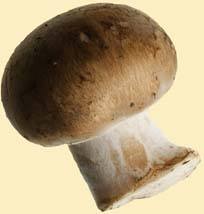
Cremini mushrooms are a variety of fungus that belongs to the white button mushroom family. The species name is Agaricus bisporus, and this family of mushrooms also includes portobello. These three mushrooms—cremini, portobello, and white button—are the three most commonly consumed in the world.
That being said, these three mushrooms are actually the same mushroom. Although they look different, the varying appearance just depends on age. White button mushrooms are the freshest and youngest, then cremini, and portobellos have been left to mature for a long time. Compared to white buttons, cremini mushrooms have a browner color, a meatier texture, and a deeper flavor.
Nutrition-wise, cremini mushrooms provide an excellent source of the following micronutrients:
Selenium: 37% DV
Riboflavin (Vitamin B2): 29% DV
Copper: 25% DV
Niacin: 19% DV
Pantothenic Acid (Vitamin B5): 15% DV
Potassium: 13% DV
Phosphorus: 12% DV
Morel
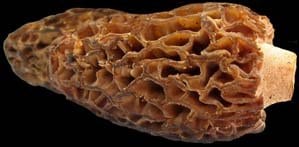
These are certainly one of the most unusual types of edible mushrooms.
Morel mushrooms (Morchella esculenta) look like honeycomb on a stick, and they have a strange, mysterious appearance which suggests we probably shouldn’t eat them. However, eat them we can, and they taste as unique as they look. If you have tried shiitake mushrooms before, then you’ll understand the “meaty” taste they have. These are like that, only much more intense and they have a kind of nutty flavor too. In short, if you like shiitake you’ll probably love Morels.
Morels are Wild—Not Commercial—Mushrooms. It’s hard to cultivate morel mushrooms on a large scale, so it is rare to find them in a store. However, we can pick our own, or we can grow them ourselves. Due to their unique appearance, many people acknowledge that morel mushrooms are the easiest—and safest—wild mushrooms to identify.
However, picking wild mushrooms can still be dangerous for those who don’t know what they are looking for. Growing kits to make your own are available too, and they can safely grow in the garden.
In regard to nutrition, morel mushrooms offer significant amounts of:
Iron: 68% DV
Vitamin D: 52% DV
Copper: 31% DV
Manganese: 29% DV
Phosphorus: 19% DV
Zinc: 14% DV
Riboflavin (Vitamin B2): 12% DV
3. Shiitake Mushrooms
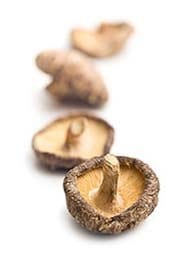
Shiitake (Lentinula edodes) is one of the most infamous types of mushrooms and for a good reason; they taste delicious. With a meaty, chewy taste, they go well with almost everything. Enjoying the most popular in Japan—their homeland—they are famous for having a variety of health benefits. For instance, they are particularly renowned for their anticarcinogenic and antimicrobial properties.
Additionally, in a randomized trial featuring 52 healthy men and women, those given dried shiitake mushrooms showed improved immunity and lower levels of CRP (a marker of inflammation). Also, the dosage was at a level that is a realistic consumption level in everyday life.
High levels of inflammatory markers are associated with most chronic diseases, so these are excellent benefits.
Per 100g, shiitake mushrooms provide the following vitamins and minerals in large amounts:
Copper: 45% DV
Pantothenic Acid: 36% DV
Riboflavin: 10% DV
Manganese: 10% DV
Zinc: 9% DV
Vitamin B6: 8% DV
Niacin: 7% DV
Shiitake mushrooms are available in dried form too, which have a powerful concentration of flavor (and nutrition). As shown above, king oyster mushrooms are one of the biggest types of edible mushrooms. They have a striking appearance and are very thick, giving them an extremely chewy and spongy texture — a little bit like squid. For this reason, roasting king oysters in the oven works best and leaves you with a deep, rich flavor — especially if you add a bit of butter and salt beforehand.
The mushroom goes by the scientific name of Pleurotus eryngii and it is native to Europe, the Middle East, and North Africa.
The mushroom is easy to identify in the wild and, outside of Japan and Australia, has no poisonous look-alikes.
Nutrient-wise, king oysters provide the following micronutrients per 100g:
Niacin: 25% DV
Riboflavin: 21% DV
Pantothenic Acid: 13% DV
Copper: 12% DV
Phosphorus: 12% DV
Potassium: 12% DV
Iron: 7% DV
Health Benefits:
Oyster mushrooms are a species that has long been used as a medicinal mushroom. Interestingly, cell studies show that they contain a significant amount of antioxidants and that these compounds have anti-tumor and anti-inflammatory effects.
As always, we cannot assume these in-cell effects translate to what happens within the human body in the absence of clinical human trials.
Also, the consumption of this edible mushroom appears to lower triglycerides and improve the LDL/HDL ratio. Although they can be a little expensive, you can pick them up for a lower price if you go to a Chinese/Asian market.
Lion’s Mane:
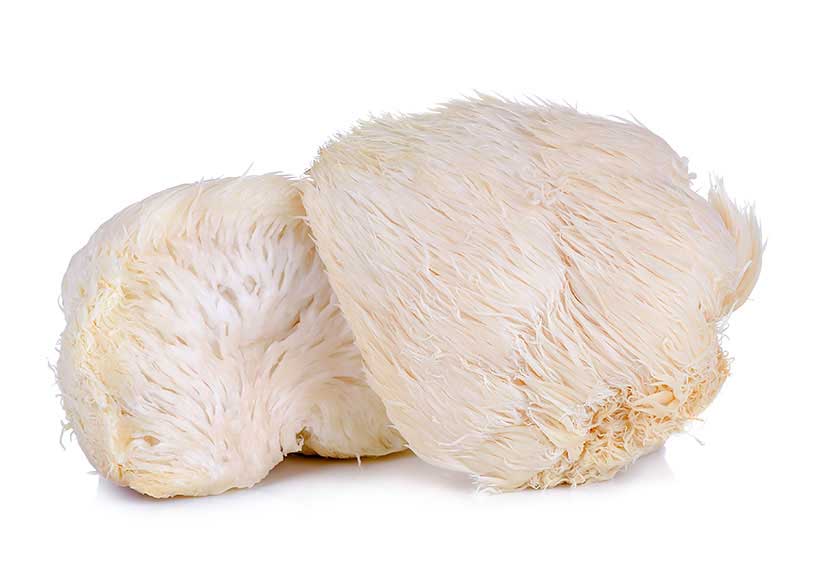
Similar to morel mushrooms, the lion’s mane mushroom (Hericium Erinaceus) has an unusual appearance. It is a large species of mushroom that looks quite unusual, as shown in the above picture.
Similar to some other mushrooms, cell studies indicate that lion’s mane mushrooms have anti-inflammatory, gastroprotective, cardioprotective, and inhibitory effects on cancer metastasis. Again, these mechanisms need replicating in human trials before we can get too excited though.
These mushrooms grow in the wild throughout Europe, North America, and Asia. Although relatively rare in Western dishes, it plays a large part in Chinese cuisine. Despite this, the mushroom has become popular in the health and supplement industry, and a variety of products are available. These include extracts, tablets, and even coffee-mix drinks.
However, rather than buying extracts, you can buy the real thing if you hunt around in some Asian grocery stores. Otherwise, you can also buy them as dried mushrooms. They taste pretty good and have a very intense meaty flavor.
6. Enoki Mushrooms
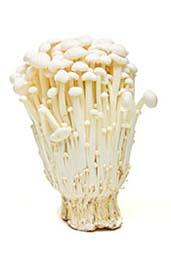
Enoki mushrooms (enokitake) are long thin white mushrooms that resemble a piece of string. Again, they are one of the more unique-looking mushroom varieties. Enoki mushrooms taste great; they are also relatively simple to grow and cheap to buy. In certain Asian and Italian dishes, they can act as a replacement for noodles and spaghetti due to their chewy texture and noodle-like appearance. For the same reason, tossing some into a stir-fry has great results.
Here are their most significant nutrients on a per-100g basis:
Niacin: 30% DV
Folate: 13% DV
Thiamine: 12% DV
Potassium: 11% DV
Pantothenic Acid: 11% DV
Phosphorus: 11% DV
Riboflavin: 10% DV
7. Button Mushrooms
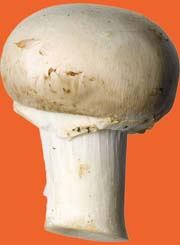
Button mushrooms (Agaricus bisporus) are the baby version of shiitake and cremini; they are still very fresh and at an early-life stage. These white mushrooms are probably the most common—and widespread—variety in the world. In fact, they represent 90% of the edible mushrooms consumed in the United States. Despite a common belief that these mushrooms aren’t as healthy as other more marketed types, they may have some interesting benefits.
First of all, their nutrient profile. Button mushrooms contain the following vitamins and minerals:
Riboflavin: 24% DV
Niacin: 18% DV
Copper: 16% DV
Pantothenic Acid: 15% DV
Selenium: 13% DV
Potassium: 9% DV
Phosphorus: 9% DV
Studies on Button Mushrooms:
In cell studies, white button mushrooms enhance the strength of cells critical to the body’s immune system (19).
In a study involving 24 healthy volunteers, 12 were assigned to eat a diet that included 100g of button mushrooms daily, and the remaining 12 ate the same control diet except for the button mushrooms. Over two weeks, secretory immunoglobulin—an antibody involved in the immune system—increased by 56% in the button mushroom group only.
Portobello mushrooms:
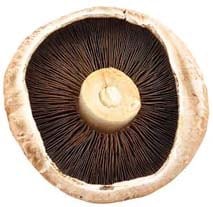
If button mushrooms are the babies, then portobello mushrooms are the grandparents. Portobello mushrooms are the same species as button mushrooms—Agaricus bisporus—but at a late stage of life. The mushrooms are therefore much bigger and wider in diameter, as well as being deeper and richer in flavor. They are one of the best types of mushrooms and baked portobellos are delicious — especially when they are stuffed with some cheese.
The mushroom provides the following major nutrients:
Riboflavin: 28% DV
Niacin: 23% DV
Copper: 20% DV
Niacin: 23% DV
Selenium: 16% DV
Pantothenic Acid: 15% DV
Potassium: 14% DV
Porcini mushrooms:
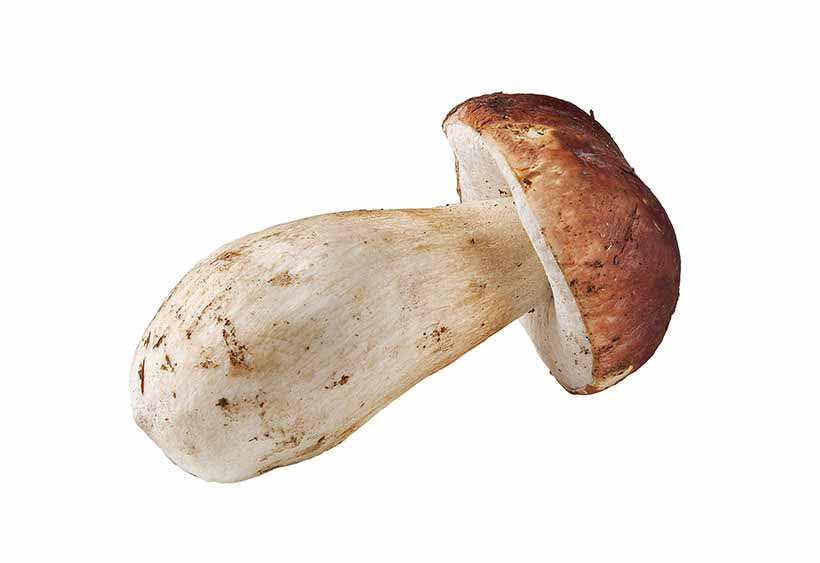
Porcini mushrooms (Boletus edulis) are one of the most popular sorts of mushrooms for culinary purposes. Taste-wise, they have a deep and mildly nutty flavor with an intense aroma. Porcini can be either purchased fresh at markets or in dried form.
Porcini mushrooms are also an attractive target for wild mushroom foragers, due to their easily identifiable features. Animal studies suggest that extracts of these mushrooms could potentially have a positive impact on markers of cardiovascular risk.
Chanterelle
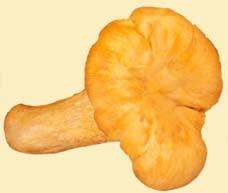
Nutritional Value
Apart from their mild peppery taste Chanterelle Mushroom is a good source of nutrients, vitamins, and minerals. Consuming 54 grams of Raw Chanterelle Mushroom offers 1.87 mg of iron, 0.191 mg of Copper,2.9 µg of Vitamin D (D2 + D3), 2.206 mg of Vitamin B3, 0.58 mg of Vitamin B5, 0.116 mg of Vitamin B2, 0.154 mg of Manganese, 273 mg of Potassium, 2.1 g of Total Dietary Fiber,31 mg of Phosphorus and 0.38 mg of Zinc.
Chanterelle Mushroom is one of Nature’s culinary delights mainly found in damp, but not swampy or marshy ground, usually near some sort of hardwood. Apart from its mild peppery taste, it is full of essential nutrients, minerals, and vitamins which are extremely important to deal with several long-term or short-term health-related difficulties.
1. Brain Function
Iron is one of the essential minerals for the increased development of the brain. Chanterelle Mushroom includes about 1.87 mg of iron which is 23.38% of the daily recommended value. Since oxygen supply in the blood is assisted by iron and the brain uses around 20% of the blood oxygen, iron is directly associated with brain health and its functions. Similarly, proper flow of blood in the brain helps to encourage cognitive activity and help to create new neural pathways to avoid cognitive disorders like dementia and Alzheimer’s disease, therefore proper iron-rich food intake is essential for the proper functioning of the brain.
2. Proper growth
Copper is one of the highly essential minerals present in Chanterelle Mushroom for normal growth and development of body parts and overall health. Therefore, it is certainly essential to include this mineral in a balanced form in the regular diets of an individual for proper growth. Apart from that, it is also helpful in protecting the skeletal, nervous, and cardiovascular systems of the body.
3. Decreased Risk of Type 2 Diabetes
As we all know Type 2 diabetes can result in some overwhelming long-term difficulties, like nerve damage, eye damage, vision loss, heart disease, and kidney failure. Chanterelle Mushroom is one of the best options for getting a sufficient amount of vitamin D which is exceptionally essential for dealing with type 2 Diabetes. Current research recommends that vitamin D may play a major role in reducing the risk of type 2 diabetes, particularly in those who are at an increased threat of this deadly disease.
Several kinds of research have shown improvements in insulin sensitivity, beta-cell function, and whole-body inflammation with regular use of ample amounts of vitamin D. One Single cup of Chanterelle Mushroom consists of 2.9 µg of vitamin D which is 19.33% of the daily recommended value, so include it in your regular diet to remain safe from Type 2 Diabetes.
4. Maintains Skin Health
Chanterelle Mushroom is one of the good sources of Vitamin B3 which in the form of niacinamide is recommended as a natural treatment for healthy skin and clearing acne when applied to the skin topically. While other people take niacin or B vitamin complex supplements to cure their symptoms.
Niacin helps to reduce skin inflammation, irritation, flare-ups, redness, and more, it is also used for handling skin conditions named bullous pemphigoid and granuloma annulare. These two are inflammation-caused skin diseases that comprise the burning of the skin which can be very painful and cause infection. Niacin or vitamin B3-rich food must be included in your normal diet to get rid of such skin problems.
5. Stress Reducer
Vitamin B5 is one of the most important vitamins which are present in Chanterelle Mushroom which is essential for reducing stress and other serious mental problems like anxiety and depression. It does this by regulating the hormones responsible for causing these mental conditions. One cup of Chanterelle Mushroom consists of 0.58 mg of vitamin B5 which is 11.60% of the daily recommended value.
6. Migraine
Adults and kids who don’t get a sufficient amount of riboflavin have the tendency to experience repeated headaches and even migraines. Riboflavin is one of the essential vitamins that can be obtained by regular consumption of Chanterelle mushrooms. As soon as a person gets sufficient riboflavin, the number of headaches is reduced. One scientific research done with 55 patients displayed that those who took 200-400 mg of riboflavin had considerably fewer migraines and headaches compared to those given the placebo. Regular consumption of this mushroom reduces both the frequency and intensity of the headaches.
7. Help Improve Muscle Mass
As we all know consuming a sufficient amount of protein is essential to build and maintain healthy muscle mass, while also supporting ligaments, tendons, and other body tissue. As soon as your diet is lacking in amino acids, muscle atrophy can take place when your muscle fibers are broken down to support your body’s energy needs.
Chanterelle Mushroom consists of ample minimal protein which is required after exercise, as physical activity persistently damages muscle tissues therefore they can repair and grow back stronger. For the process to happen efficiently, you have to include some extra protein-rich foods like Chanterelle Mushroom to help repair the damage. While protein alone cannot improve athletic performance, research shows that consuming protein before and after exercise helps upsurge muscle recovery, encourages muscle synthesis, and helps as effective muscle ache treatment.
8. Alleviating PMS Syndrome
Numerous women are suffering from premenstrual syndrome (PMS) throughout the world. It is one of the serious problems that take place in the majority of women. Hence, manganese can be useful to reduce these monthly situations like mood swings, depression, headaches, and irritability. Women who suffer from severe PMS symptoms are advised to consume manganese-rich food such as Chanterelle Mushroom as it consists of 0.154 mg of manganese which is 6.70% of the daily recommended value.
Nutritional value
Apart from their mild, fruity taste, the Enoki mushroom is a good source of nutrients, vitamins, and minerals. Consuming 65 grams of enoki mushroom offers 4.571 mg of Vitamin B3, 0.878 mg of Vitamin B5, 0.146 mg of Vitamin B1, 0.13 mg of Vitamin B2, 68 mg of Phosphorus, 0.75 mg of iron, and 0.07 mg of Copper. Moreover, many Amino acids 0.026 g of Tryptophan, 0.072 g of Threonine, 0.058 g of Isoleucine, 0.084 g of Leucine, and 0.084 g of Lysine also found in 65 grams of Enoki mushroom.
Health benefits of Enoki Mushroom:
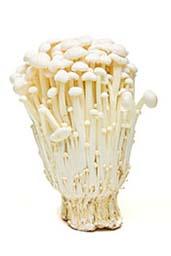
Enoki has got enoki linoleic acid as well as enoki chitosan along with being loaded with dietary fiber. Raw enoki mushrooms have been proven to include around two times the fiber of cabbage. Linoleic acid, chitosan, as well as dietary fiber, provide you with enoki mushroom benefits like being able to lose body fat within your gut, take control of your blood sugar levels, and prevent bowel problems. Listed below are some of the popular health benefits of Enoki mushroom:
1. Immune-Boosting Benefits
Enoki mushrooms provide a smorgasbord of nutrition as well as antioxidants. They are full of thiamine, niacin, potassium, riboflavin, pantothenic acid, calcium, copper, iron, and selenium, and low in dietary cholesterol and sodium. Amino acid’s valine, lysine, and ergothioneine fortify the immune-heightening properties of the enoki. Appreciated because of its health advantages, the enoki mushroom has been utilized in traditional Chinese and Japanese medication for hundreds of years as a tonic for liver disease, high cholesterol levels, stomach ailments, and high blood pressure levels.
2. Helps you lose body fat in your gut
Enokitake mushrooms function as a non-meat source of conjugated linoleic acid (CLA) that will assist in reducing body fat. Enokitake mushroom CLA has the same weight loss advantages as CLA from meat sources.
Enoki mushroom consists of linoleic acid which helps to decrease gut fat. It is stated to switch on enzymes liable for burning up visceral fat. Therefore, helping you drop gut fat. So, including enoki mushrooms in your diet will help you decrease body fat.
3. Balance Sugar Level
There are many advantages to getting more fiber in your daily diet like lowering your levels of cholesterol as well as bringing down unwanted weight. Apart from that, another benefit of dietary fiber is it improves blood sugar control. What better blood glucose control means in weight reduction is that it leads to less sugar being stored away as fat.
Enoki mushrooms are full of dietary fiber that will help you manage blood glucose levels. Spikes in blood sugar result in insulin levels, telling the body to store fat. However, fiber might help enhance blood glucose levels simply by reducing the effect of glucose levels on insulin. In other words, what it does is slow down the assimilation of sugar. By reducing the influence glucose within your bloodstream has on insulin, in effect, you keep the body from storing fat away. Additionally, it works as a precautionary measure for type 2 diabetes.
4. Prevent constipation and normalize bowel movements
The fiber in enoki mushrooms helps to normalize bowel motions and prevents constipation. 12 grams of dietary fiber is found in 300 grams of enokitake mushrooms which is 30 to 50 % of the daily fiber suggested by the Institute of Medicine for males and females of 50 years old and younger. However, people below 51 need more fiber.
Insufficient fiber in your daily diet may disturb normal bowel motions and may result in constipation. Enokitake mushrooms are one of the best low-calorie sources of dietary fiber to prevent constipation.
5. Promote intellectual development
Enoki mushroom consists of a good amount of amino acid which could encourage and foster mental development as well as enhance memory. Enoki mushroom becomes essential for the maintenance of health and conditioning of the intelligence of kids, for the life extension of the age, and also to enhance the memory of adults. It really is honored as a “fungus which encourages intellectual development.”
6. Prevent Allergy
Frequent use of enoki mushrooms helps to prevent asthma, rhinitis, eczema as well and other allergic reactions. So include it in your regular diet to remain healthy and allergy-free.
7. Lower blood lipids
Enoki mushroom consumption helps to prevent the rise of blood lipids, decrease cholesterol to avoid hyperlipidemia and lower the occurrence of coronary disease.
8. Promote metabolism
Regular use of the enoki mushroom encourages the biological activity of the body to improve the metabolic process that encourages the absorption of nutrition. For instance, repeated daily doses of the mushroom resulted in significant decreases in blood pressure, triglycerides, and an increase in HDL.
Health benefits of Wood ear mushroom:
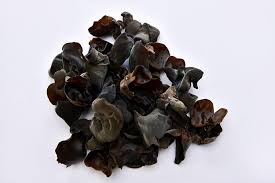
Wood ear mushrooms have biological activities such as anti-cancer properties, antiviral properties, antioxidant, immunomodulatory, anti-inflammatory, anti-cholesterol, anti-diabetic, and anticoagulant activity.
1. Antibacterial properties of Wood ear mushrooms
Polysaccharides of Wood ear mushrooms help in protection against different bacteria such as Escherichia coli and Staphylococcus aureus which have great potential as antimicrobial properties and can be a supplementary food for human health.
2. Manage diabetes
Wood ear mushrooms are rich in dietary fiber (71%) mainly insoluble dietary fiber (IDF) which is beneficial for lowering the glycemic index. Therefore, incorporation of Wood ear mushroom powder into the extruded snack reduced the glycemic level after ingestion (6). Moreover, this mushroom also contains polysaccharides which reduce food intake and slightly lower the plasma and urinary glucose levels.
3. Active component diazane in Wood ear mushrooms possess anti-tumor properties
The presence of an anti-tumor active component (diazane) in wood ear mushroom act as a cytotoxic agent that possesses potent anti-tumor activity against bronchoalveolar cancer, sarcoma, and gastric cancer cells, inhibit the proliferation of the tumor cells, induce apoptosis and may be used as a functional additive for enhancing antioxidant activities and suppressing tumor growth in the body. Moreover, polysaccharides from wood ear mushrooms increase treatment response rate and survival rate and improve immune function without increasing the incidence of adverse effects in patients with gastrointestinal cancers.
4. Wood ear mushrooms lower the cholesterol level
Polyphenolic compounds (more than 16%) found in Wood ear mushrooms possess potent hypocholesterolemic effects by improving antioxidant status, decreasing the level of total cholesterol and atherosclerosis index, increasing the level of high-density lipoprotein cholesterol and fecal excretion of bile acid’s (10). Furthermore, Wood ear mushrooms contain polysaccharides which significantly lowered the concentrations of serum total cholesterol and low-density lipoprotein. Therefore, Wood ear mushrooms possess preventive actions against hypercholesterolemia.
5. Anticoagulation properties
Polyphenolic compounds mainly mannose, glucose, glucuronic acid, and xylose present in wood ear mushrooms act as a novel alternative agent that catalyzes thrombin inhibition by antithrombin and inhibits platelet aggregation and blood clotting. Thus, polysaccharides from these mushrooms may constitute a new source of compounds with action on coagulation, platelet aggregation, and, perhaps, thrombosis.
6. Antioxidant properties
A research study suggested that wood ear mushrooms possess high antioxidant activities, which significantly inhibit lipid peroxidation, oxidative damage, and potent hydroxyl radical scavenging activity than catechin (standard drug). Thus, wood ear mushrooms may be helpful in potential therapeutic use.
7. Radioprotective properties due to melanin pigments
Wood ear mushrooms are a good source of melanin pigment which may be against ionizing radiation. Thus, Wood ear mushroom melanins possess the ability to mediate local shielding against external radiation.
8. Anti-quorum-sensing properties
Wood ear mushrooms contain a bioactive pigment that may interfere with the bacterial quorum-sensing system, regulate its associated functions, and prevent bacterial pathogenesis. Therefore, wood ear mushroom pigments or specific compounds may be used in humans as a novel quorum-sensing inhibitor to control and handle detrimental infections.
9. Immunomodulatory properties
Wood ear mushrooms enhance the survival, and immunostimulatory activity in phagocytes and induce host protection against neoformans, which may be beneficial as an adjuvant for vaccines or antifungal therapy.
10. Polysaccharide Herein of Wood ear mushrooms can be used as an oral drug delivery
Wood ear mushrooms polysaccharide known as herein has several advantages like biodegradability, biocompatibility, low expense, and ease of production which can be used as an innovative biomaterial of oral protein drug delivery system. Thus, herein of the wood ear, mushroom-based hydrogel may be beneficial as an effective polymeric carrier for oral protein drugs.
11. Antiviral properties of Wood ear mushrooms due to sulfated polysaccharide
Sulfated polysaccharides of mushrooms combined with viruses or cells thus prohibit virus adsorption or inhibit some steps of virus replication after entering the cell. Therefore, these mushroom polysaccharides emerge as a new antiviral drug that attaches the HIV-1 protein so that the virus cannot combine with polysaccharides to further prevent progression.
12. Treats anemia
Wood ear mushroom polysaccharide iron complex possesses high antioxidant activity which binds to the iron to promote digestion and absorption and is helpful for the treatment of iron deficiency anemia, it also reduces oxidative stress caused by the overload of iron improving the blood parameters and body weights of iron deficiency anemia patient.
13. Prevents obesity
Wood ear mushrooms contain a natural bioactive substance that results in reducing body weight and adipose tissue mass by suppressing the expression of adipogenic/lipogenic genes and reducing the risk of hepatic steatosis by modulating plasma lipids and liver enzymes.
14. Healthy heart
Age is a major risk factor for cardiovascular disease including heart disease. However, intake of Wood ear mushrooms acts as a natural antioxidant that allows improvement of heart function through restoration of the redox balance of these organs. Therefore, Wood ear mushroom polysaccharides may improve heart function, especially in aging animals, and retard the aging process.
15. Anti-inflammatory properties
Wood ear mushrooms are a good source of polysaccharides that prevent inflammation and may be helpful for the treatment of different kinds of acute and chronic inflammatory diseases like wound healing, edema, and rheumatoid arthritis.
Nine potential health benefits of Chaga mushrooms
The Chaga mushroom grows on birch trees throughout the northern hemisphere. It resembles a dark clump of dirt more than a mushroom but is distinguished from other growths by its orange tissue.
Doctors, alternative medicine advocates, and researchers are increasingly interested in the potential health benefits of the Chaga mushroom (Inonotus obliquus). Some studies on Chaga mushrooms have yielded promising results.

Chaga mushrooms are rich in a wide variety of vitamins, minerals, and nutrients, including:
- B-complex vitamins
- vitamin D
- potassium
- rubidium
- cesium
- amino acids
- fiber
- copper
- selenium
- zinc
- iron
- manganese
- magnesium
- calcium
2. Slowing the aging process
Oxidative stress causes physical signs of aging, such as wrinkles, sagging skin, and gray hair. Exposure to sun, pollution, and other sources of damage create too many free radicals for the body to neutralize, which accelerates the aging process of the skin.
In theory, supplying the body with more antioxidants could slow the aging process, or even reverse visible signs of aging.
Although no research has conclusively linked chaga to anti-aging benefits, its effectiveness in fighting other forms of oxidative stress suggests that it could also fight aging.
3. Lowering cholesterol
Chaga mushrooms contain many antioxidants that may reduce low-density lipoprotein (LDL), the so-called “bad” cholesterol.
High cholesterol is a significant risk factor for heart disease, so Chaga mushrooms could be useful in the fight against cardiovascular disease.
4. Preventing and fighting cancer
Increasingly, researchers are taking seriously the possibility that Chaga mushrooms may be able to prevent cancer and slow its growth.
Chaga is rich in antioxidants, which are chemicals that help prevent cell damage caused by free radicals or oxidants. When the body is unable to produce enough antioxidants to prevent this damage, oxidative stress occurs. Oxidative stress can cause cancer and a host of other health problems.
A 2010 study found that Chaga could slow the growth of lung, breast, and cervical cancer cells in a petri dish. The same study also found that Chaga could slow the growth of tumors in mice.
A 2009 study found that triterpenes, the compounds found in Chaga and some other mushrooms, cause tumor cells to self-destruct. Unlike other cancer treatments, however, Chaga does not appear to harm healthy cells.
Although other studies have found similarly promising results, they have all been carried out on animals or in a laboratory. To prove the anti-cancer benefits of Chaga conclusively, researchers will need to conduct extensive studies on humans.
5. Lowering blood pressure
Research suggests that oxidative stress is a contributing factor to high blood pressure. People with high blood pressure are more prone to heart attacks, strokes, and other cardiovascular health issues.
Chaga’s antioxidants could have a potential role in lowering blood pressure and preventing poor cardiovascular health.
6. Supporting the immune system
Cytokines are the immune system’s chemical messengers. They are proteins that play a vital role in stimulating white blood cells, which are the immune system’s first line of defense against a range of illnesses.
Some research on mice suggests that Chaga may help regulate the production of cytokines, supporting the immune system by helping cells communicate with one another. This could help fight infections, from minor colds to life-threatening illnesses.
7. Fighting inflammation
When the body is fighting an illness, inflammation supports the fight. But sometimes, inflammation transitions from a short-term attack to a chronic health problem.
Some illnesses, particularly chronic conditions such as rheumatoid arthritis, are linked to inflammation. Recent research suggests that some conditions that are not considered inflammatory, including depression, may be partly due to chronic inflammation.
Chaga’s role in regulating cytokine production may also help control inflammation. This points to a role for Chaga in fighting autoimmune conditions and possibly some other diseases.
8. Lowering blood sugar
Chaga might also have a role in the fight against diabetes.
A 2006 study found that Chaga mushrooms could lower blood sugar in rats. The rodents were genetically modified to have diabetes and to be obese. After eating Chaga mushrooms for 8 weeks, their blood sugar levels were lower.
Though no research has been done on humans yet, this suggests that Chaga might contribute to an alternative treatment for diabetes in the future.
9. Preventing drug side effects
Research is still in its infancy, but if Chaga proves effective at fighting illnesses such as cancer and arthritis, it could be an alternative to traditional treatments.
Treating people with Chaga mushrooms could prevent them from experiencing the side effects of other treatments, such as chemotherapy, radiation, and various medications prescribed for chronic illnesses.
People planning to make their own Chaga supplements, or who wish to incorporate Chaga into their diet, should consult a doctor before doing so. The right daily intake of Chaga varies depending on treatment goals.
Chaga is not a substitute for other forms of medical care, so people who have conditions such as cancer, diabetes, or high blood pressure should continue with their usual treatment.
Instead, Chaga can be incorporated as a supplement under the direction of a doctor.
As with other supplements and medications, Chaga carries some risks. It can also trigger side effects and may interact dangerously with some medications.
Because Chaga mushrooms lower blood sugar, it can be dangerous for people taking insulin and other blood sugar-lowering medications.
To reduce the risks of using Chaga mushrooms, a person should consider the following:
- Continue taking all prescribed medications, as Chaga is not a substitute for traditional medicine.
- Tell a doctor about all the medications being used. As with other drugs and supplements, Chaga may alter the effectiveness of various medications.
- Write down any side effects from Chaga’s use. Though rare, Chaga can trigger an allergic reaction in some people. Trouble breathing, changes in heart rate, and loss of consciousness are medical emergencies.
- Avoid using other herbal supplements while taking Chaga, unless a doctor advises otherwise.
- Research supplement brands and buy from reputable sources, as Chaga is not monitored by the U.S. Food and Drug Administration (FDA).
Benefits of Turkey Tail Mushrooms
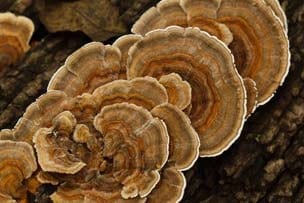
Cancer Fighter
Research has demonstrated that turkey tail mushrooms may have antitumor properties, thought to be related to its immune-boosting effects.
One test-tube study found that PSK, the polysaccharopeptide found in turkey tail mushrooms, inhibited the growth and spread of human colon cancer cells.
Furthermore, a certain type of polysaccharide found in turkey tail mushrooms called Coriolus Versicolor glucan (CVG) may suppress certain tumors. A study in tumor-bearing mice found that daily treatment with CVG extracted from turkey tail mushrooms significantly reduced tumor size. Researchers attributed this development to enhanced immune response.
Another study demonstrated that daily treatment with turkey tail mushroom extract significantly slowed the spread of cancer cells in dogs with (hemangiosarcoma).
The most impressive evidence regarding the anticancer benefits of turkey tail mushrooms is when it’s used in combination with more traditional treatments, such as chemotherapy and radiation.
Good for The Gut
Turkey’s tail contains prebiotics, which helps nourish beneficial bacteria like Bifidobacterium and Lactobacillus while reducing potentially harmful bacteria, such as Clostridium and Staphylococcus.
An 8-week study in 24 healthy people found that consuming 3,600 mg of PSP extracted from turkey tail mushrooms per day led to beneficial changes in gut bacteria and suppressed the growth of the possibly problematic E. coli and Shigella bacteria.
Having healthy levels of Lactobacillus and Bifidobacterium bacteria has been linked to improved intestinal symptoms like diarrhea, enhanced immune system, reduced cholesterol levels, lower risks of certain cancers, and improved digestion.
Additional Benefits of Turkey Tail Mushroom
- Fights HPV: A study of people with HPV found that once treated with turkey tail experienced clearance of HPV.
- May improve athletic performance: A mouse study showed that turkey tail extract improved exercise performance and reduced fatigue. Plus, the mice treated with turkey tail experienced lower blood sugar levels at rest and post-exercise.
- May improve insulin resistance: A study in rats with type 2 diabetes demonstrated that turkey tail extract significantly reduced blood sugar levels and improved insulin resistance.
Is Turkey Tail Safe?
Turkey tail mushroom is considered safe, with few side effects reported in research studies.
Some people may experience digestive symptoms like gas, bloating, and dark stools when taking turkey tail mushrooms.
When used as a cancer treatment alongside chemotherapy, side effects including nausea, vomiting, and loss of appetite have been reported.
Another potential side effect of consuming turkey tail mushrooms is the darkening of the fingernails.
It is recommended to speak with your doctor before supplementing with the turkey tail mushroom.
Ananda Organics Turkey Tail Mushroom Extract is Extracted using organic cane alcohol and Canadian Turkey Tail mushrooms from Northwestern Ontario. visit www.annandachaga.com for more details.
Please note there are some side effects to some of these mushrooms. It is always advisable to consult with a health practitioner before consuming any of these mushrooms!!!
Thank you for reading.
Michael.
Comments are welcome
Hello, great post on mushrooms and their health benefits. I love eating mushrooms and my favorite ones are the cremini which I like to sautee with a bunch of green beans. I also like Enoki mushrooms which are good for eating in soup with some udon noodles.
The way you laid it out is perfect and informative, I never knew mushrooms were so healthy. I actually heard some people say before that mushrooms have no nutritional value, now I know they’re wrong. There’s so many different kinds of mushrooms I haven’t tried before, if I come across some new ones I’m gonna have to try them out for sure.Thanks for bringing it to my attention!
My doctor recently told me I was low on vitamin D and I was prescribed with some supplements, but I never knew mushrooms can actually have a really good impact on my health when it comes to that. I have personally never tried any mushrooms, but now that I’m aware of the great benefits it has, I may dig deeper into trying them out.
Hello, I really want to appreciate your effort in putting together this website and writing this article. I am amazed. I mean really amazed. I knew from the onset that mushrooms were essential and important but I didn’t know that it was to this extent. You have really brought to light the secret benefits of mushrooms to us as humans and to our world in general